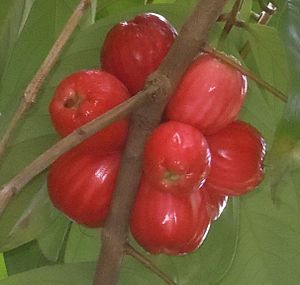Syzygium malaccense facts for kids
Quick facts for kids Malay (rose) apple |
|
|---|---|
 |
|
| Conservation status | |
|
Rare (NCA)
|
|
| Scientific classification | |
| Genus: |
Syzygium
|
| Species: |
malaccense
|
| Synonyms | |
|
|
The Syzygium malaccense is a beautiful flowering tree that grows in warm, tropical places. It is originally from Malesia and Australia. People have been growing this tree for a very long time, even before history was recorded! Ancient people called the Austronesian peoples carried these trees with them when they traveled to new islands. They were known as "canoe plants" because they were so important. Today, you can find the Malay apple growing in many warm countries around the world, including islands in the Caribbean.
Contents
Names of the Malay Apple
The Syzygium malaccense has many different English names. You might hear it called the Malay rose apple or just Malay apple. Other common names include mountain apple, rose apple, Otaheite apple, and pink satin-ash. In some places, it's known as pommerac. This name comes from a French phrase meaning "Malayan apple." Even though it's sometimes called the otaheite cashew, it's not related to the cashew plant at all. Cashew nuts can cause allergies for some people, but the Malay apple fruit has not been known to cause any allergic reactions.
What the Malay Apple Looks Like
Many people think the Malay apple tree, with its flowers and fruit, is one of the most beautiful trees in its family, Syzygium. The fruit is shaped like an oval and is usually a dark red color. However, some types can have white or pink skins. Inside, the fruit has white flesh and a large seed in the middle. It has a mild but refreshing taste. People often make jam from the fruit by cooking the flesh with brown sugar and ginger.
Where and How It Grows
The Malay apple is a tree that loves warm weather. It cannot handle freezing temperatures, which can damage it. It grows best in places that are very humid, with lots of rain, usually more than 150 centimeters (about 60 inches) each year. This tree can grow in many different places, from right next to the sea level all the way up to about 2,740 meters (about 9,000 feet) high. The tree itself can grow quite tall, reaching between 12 and 18 meters (about 40 to 60 feet) in height. It usually blooms with flowers in early summer, and then the fruit is ready to pick about three months later. In Costa Rica, the flowers appear earlier, and the fruit is ripe in April. Farmers who grow coffee sometimes plant Malay apple trees to give shade to their coffee plants and to attract birds away from their coffee beans.
In Hawaii, the Syzygium malaccense is called mountain apple or 'Ōhi'a 'ai. When the Polynesians first arrived in the Hawaiian Islands, they brought important plants and animals with them. The mountain apple was one of these special "canoe plants" that arrived between 1,000 and 1,700 years ago.
Nutrition and How We Eat It
The mountain apple is a fruit you can eat when it's raw and ripe. In Puerto Rico, people use the Malay apple to make wines. In Hawai'i, the fruits are eaten just like you would eat an apple. In Indonesia, people even eat the flowers of the tree in salads! In Guyana, the skin of the mountain apple is cooked down to make a sweet syrup. The mountain apple has white, fleshy fruit that feels a bit like a pear when you bite into it, but it's not as sweet as an apple.
Because the mountain apple has a lot of water, it has fewer calories than other apples like a Gala or Fuji apple. It also contains a good amount of vitamins and minerals. Here is a table showing some of the nutrients found in Malay apples from Hawai'i, El Salvador, and Ghana.
| Food Value Per 100g of Edible Portion | |
|---|---|
| Moisture | 90.3-91.6 g |
| Protein | 0.5-0.7g |
| Fat | 0.1-0.2 g |
| Fiber | 0.6-0.8 g |
| Ash | 0.26-0.39 g |
| Calcium | 5.6-5.9 g |
| Phosphorus | 11.6-17.9 g |
| Iron | 0.2-0.82 g |
| Carotene | 0.003-0.008 mg |
| Vitamin A | 3-10 I.U. |
| Thiamine | 15-39 mcg |
| Riboflavin | 20-39 g |
| Niacin | 0.21-0.41 mg |
| Ascorbic Acid | 6.5- 17.0 mg |
A Bit of History
In 1793, a famous captain named William Bligh was given a special job. He was asked to collect tasty fruits from the Pacific Islands and bring them to Jamaica. The Malay apple was one of the important species he was asked to find.
Gallery
See also
 In Spanish: Syzygium malaccense para niños
In Spanish: Syzygium malaccense para niños







